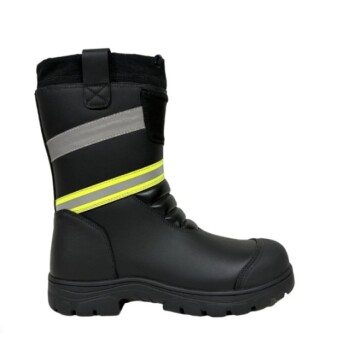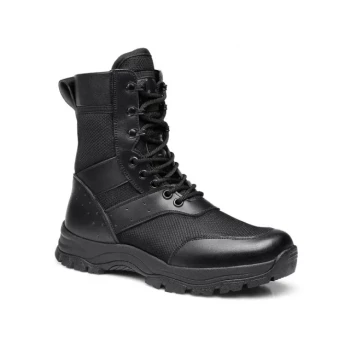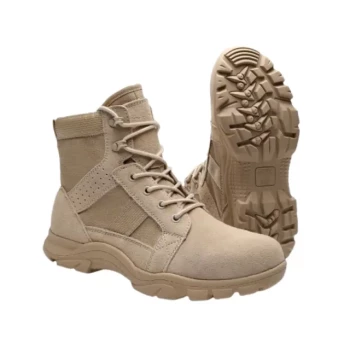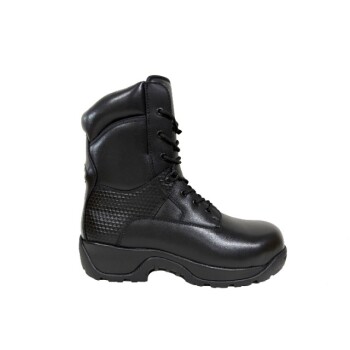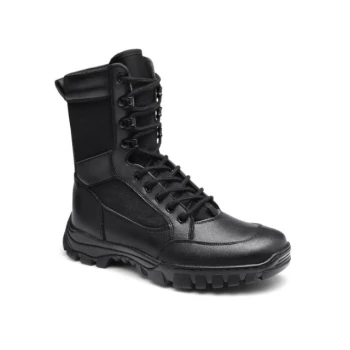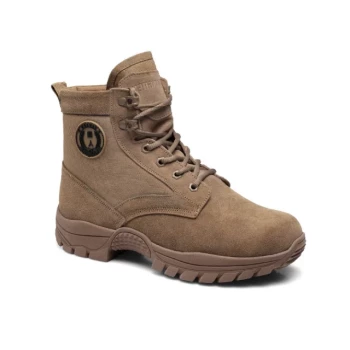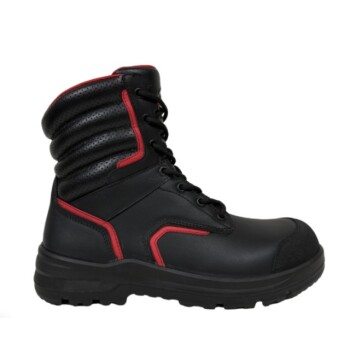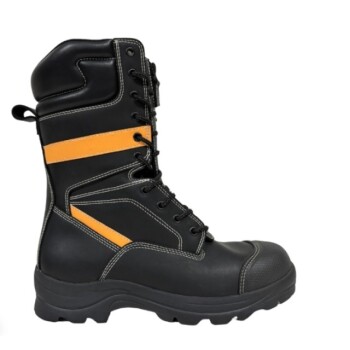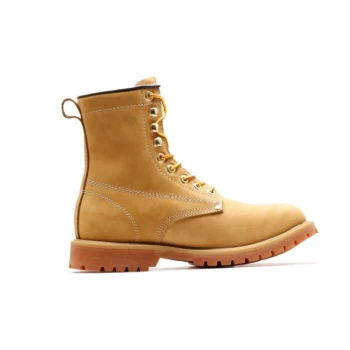Wildland firefighters wear specialized, heavy-duty leather boots designed for extreme conditions. These boots must be at least 8 inches tall, feature melt-resistant soles, and adhere to strict safety standards like the NFPA 1977 to provide the necessary protection and support on the fireline.
The specific boot worn by a wildland firefighter is not about brand or style, but about meeting non-negotiable safety standards. The right boot is a critical piece of personal protective equipment engineered for heat resistance, durability, and stability on unpredictable terrain.
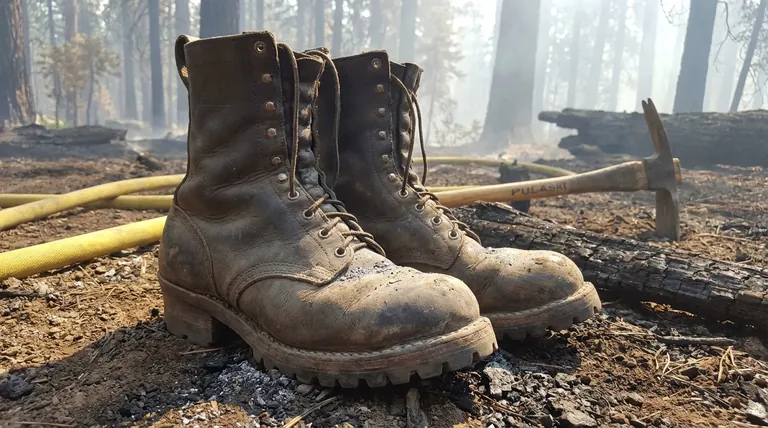
The Anatomy of a Wildland Fire Boot
To understand why specific boots are required, you must first understand their fundamental components. Each feature serves a critical function for safety and performance in the field.
All-Leather Upper Construction
The standard for wildland boots is a high-quality, all-leather upper. This material provides superior durability and essential resistance to heat and embers.
Unlike many work boots, these are not typically made with synthetic fabrics, which can melt when exposed to high temperatures, posing a severe risk to the firefighter.
The Critical 8-Inch Height
The minimum height requirement of 8 inches is for ankle support and protection. This height helps stabilize the ankle on steep, uneven terrain, reducing the risk of sprains and injuries.
It also creates a crucial barrier, preventing hot embers, ash, and sharp debris from entering the boot.
Melt-Resistant, Slip-Resistant Soles
The outsole is one of the most critical safety features. It must be made from a heat-resistant compound that will not melt or delaminate when walking over hot ground.
These soles are also designed with a deep, aggressive tread to provide maximum slip-resistance and stability on loose soil, rock, and ash.
Advanced Support Systems
Many firefighters prefer a lace-to-toe design. This construction provides more eyelets, allowing for precise control over the boot's tightness and a more customized, supportive fit.
Boots also feature reinforced heel counters to lock the heel in place, further enhancing stability and reducing friction that can cause blisters during long shifts.
The NFPA 1977 Standard: Your Baseline for Safety
The most important factor distinguishing a true fire boot from a standard work boot is its certification. This standard is the definitive benchmark for safety and performance.
What the Standard Guarantees
NFPA 1977 is the "Standard on Protective Clothing and Equipment for Wildland Fire Fighting." Boots that meet this standard have been rigorously tested for heat resistance, flame resistance, durability, and traction.
Compliance with this standard ensures the footwear provides the minimum level of protection required for the hazardous environment of a wildland fire.
Beyond the Standard
While NFPA 1977 is the baseline, some agencies or departments may have additional or more specific requirements for their firefighters' footwear. Always verify requirements with the specific employer.
Understanding the Trade-offs: Durability vs. Initial Comfort
A common mistake is judging a fire boot by the same standards as a casual hiking boot. The priorities are fundamentally different, and what seems like a downside is often a sign of quality.
The Necessary Break-in Period
A new pair of wildland fire boots should not feel perfectly comfortable right out of the box. They are built with thick, stiff leather for maximum durability and support.
Firefighters must plan for a break-in period to allow the leather to soften and conform to their feet. It is critical to order new boots before the old ones are completely worn out to allow for this.
Why "Too Comfortable" Is a Red Flag
If a new boot feels exceptionally comfortable immediately, it may be a sign that the materials are not robust enough to withstand the abuse of the fireline.
Insufficiently durable boots can fail at a critical moment, compromising both safety and the ability to perform the job effectively.
How to Apply This to Your Goal
Choosing the right boot depends on ensuring it meets the non-negotiable safety standards for the task at hand.
- If your primary focus is meeting safety requirements: The first and most important step is to verify the boot is certified to the NFPA 1977 standard.
- If your primary focus is long-term performance: Select a boot with a durable, all-leather construction and a supportive lace-to-toe design, and commit to a proper break-in period.
- If your primary focus is replacing worn-out gear: Plan ahead by ordering new boots well before your current pair fails, ensuring you have adequate time to break them in without compromising safety.
Ultimately, the right wildland boot is an essential tool that provides a stable, protective platform for operating in the world's most dangerous environments.
Summary Table:
| Key Feature | Purpose & Benefit |
|---|---|
| All-Leather Upper | Superior heat & ember resistance; no melting synthetic materials. |
| 8-Inch Minimum Height | Critical ankle support & protection from debris on uneven terrain. |
| Melt-Resistant Sole | Prevents sole failure when walking over hot ground for maximum safety. |
| Lace-to-Toe Design | Provides a more customized, secure, and supportive fit for long shifts. |
| NFPA 1977 Certification | The baseline guarantee of safety, tested for heat, flame, and durability. |
Need NFPA 1977 Certified Wildland Fire Boots for Your Team?
As a large-scale manufacturer, 3515 produces a comprehensive range of heavy-duty, safety-compliant footwear for distributors, brand owners, and bulk clients. We specialize in crafting durable, all-leather boots built to the exacting standards required by wildland firefighters.
Partner with us to ensure your team has the essential protective gear they need.
Contact our experts today to discuss your requirements
Visual Guide

Related Products
- High Performance Fire-Retardant Waterproof Safety Boots
- Durable Leather Tactical Boots Wholesale & Custom Manufacturing for Brands
- Wholesale Waterproof Tactical Boots Custom Suede & High-Traction Soles
- Durable Leather High-Ankle Tactical Boots for Wholesale & Custom Manufacturing
- Wholesale Lightweight Tactical Boots Custom Manufacturer for Desert & Combat Use
People Also Ask
- How should one choose between steel toe and composite toe shoes? Match Your Work Hazards for Optimal Safety
- How can comfort be improved when wearing steel toe boots? A Guide to Pain-Free Workdays
- What standards are used to test and rate safety-toe footwear? Ensure Your Boots Are Truly Protective
- What are the different types of materials used in the toe portion of safety toe work boots? A Guide to Steel, Alloy & Composite
- What factors should be considered when choosing between steel and composite toe caps? Ensure Maximum Safety and Comfort
